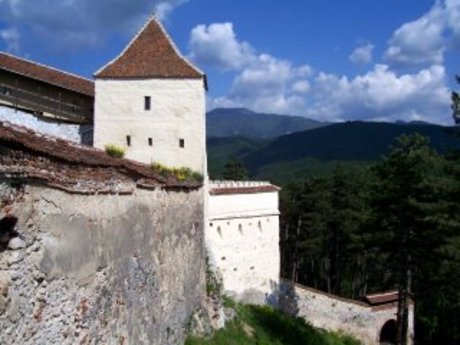Rasnov Castle
Rasnov Fortress (Rosenau in German), is located on a rocky hilltop in the Carpathian mountains, 200m above the town of Rasnov in Romania. It is 15 km southwest of Brasov and also about 15 km from Bran Castle. The fortress is on the Bran Pass, a trade route connecting Wallachia with Transylvania. The view from the top of the castle hill is spectacular.
Râsnov is a town in Braşov County, Romania with a population of under 16,000. It is located at about 15 km from the city of Braşov and about the same distance from Bran, on the road that links Wallachia and Transylvania.
It is possible this name is derived from Slavic "žrŭnovy", meaning (village or valley) "of the mill". In 14th century, German documents used the name Rasnov, but the modern German name, Rosenau, is based on a popular etymology, being influenced by the German word "Rose".
In Râşnov a citadel was built around the year 1215 by the Teutonic Knights and it was mentioned for the first time in 1331. The citadel was conquered only once in its history, around the year 1600 by Gabriel Báthory.
Saxons first settled in Transylvania in the 11th century, and the Saxon town of Rasnov was founded in 1225. Following the first Tartar invasion of 1241, a series of fortresses were constructed by the Teutonic Knights to defend the people. Rasnov Fortress is one of these peasant fortresses. This castle differs from some in that it was meant to be a place of refuge for the commoners from sieges over extended periods of time. As such it had at least 30 houses, a school, a chapel, and other buildings more commonly associated with a village.
There is a myth attached to Râşnov Fortress. During a particularly long siege of the fortress, the citizens of Râşnov were concerned about the lack of available fresh drinking water. Two Turkish soldiers, having been captured earlier, were put to the task of digging a well in the centre of the fortress. These two men were assured that they would be given their freedom once the well was completed. According to local legend, it took them 17 years to finish the well, but they were still killed afterwards. This famous well still sits in the centre of Râşnov Fortress, and is 143 metres deep.
To ensure protection against both Turkish and Tartar invasions and the trespasses of the feudal noblemen, the inhabitants of Rasnov erected a refuge and a fortress on the top of the hill in the 13th century. Attested by documents since as early as 1335, the fortress was reinforced with ramparts, towers and bulwarks that made it one of the most solid Transylvanian fortresses in the 15th century. Although under multiple sieges along the centuries, the fortress protected the lives and the properties of the inhabitants of Rasnov and of the neighbouring villages.
The first written record for the fortress is from 1331, and when the Tatars invaded in 1335, Rasnov Fortress was already strong enough to offer resistance. The castle has an upper and lower section, with polygonal perimeter walls reaching an average height of 5m. The east side is the most heavily fortified, and the walls on both that side as well as the northwest side are doubled. The defenses include 9 towers, 2 bastions, and a drawbridge. As Turkey and Austria battled over Transylvania, arms were stockpiled in the defense corridors at the walls.
In March of 1612 Rasnov Fortress was besieged by Gabriel Bathory (a Prince of Transylvania), and surrendered in April after the secret route to their water supply was found. Bathory's forces settled into the fortress and held off two attempts to win it back by joint forces from the towns of Rasnov and Brasov. The following year a ransom was paid, and Bathory and his forces left.
With the location of their water supply no longer a secret, the need for a well inside the fortress became more evident. With the castle atop a calcareous mountain, however, it meant digging down 146m through solid rock. Work on the well began in 1623 and took 17 years to complete. The work was done by two Turkish prisoners who were promised their freedom once it was finished. The well provided extra security as it meant the people didn't have to go outside the gates at all during a siege. It was in use until 1850 when the wheel broke.
The last siege of Rasnov Fortress took place in 1690 during the last Turkish invasion of Transylvania. It was damaged by fire in 1718 and rebuilt the following year. The next major damage occurred as the result of an earthquake in 1802. The fortress was last used as a place of refuge during the revolution of 1848, and was abandoned after that. Reconstruction is currently being undertaken at the fortress.
Rasnov Castle ceases to function as a fortress during the 50 years of the last century. Around this time it became a tourist attraction, where today you can visit the interesting historical museum, preserving the precious religious and historical objects and documents.
According to some historians, Rasnov castle is one of the seven Bulgarian Transylvanian castles. It probably was built by the Bulgarians in the course of historical events and was then inherited by the Hungarians and Austrians. It is believed that originally the hill above Rasnov was an ancient Roman and Thracian castle, which bore the name - Comidava.




